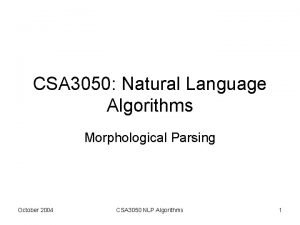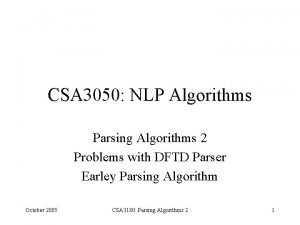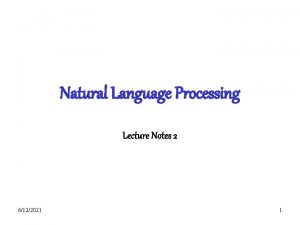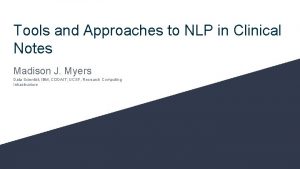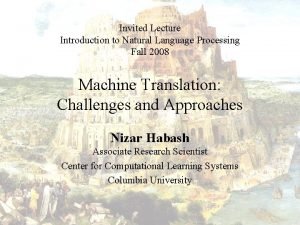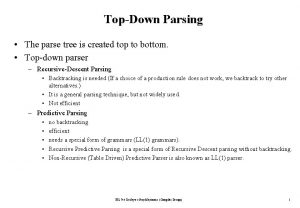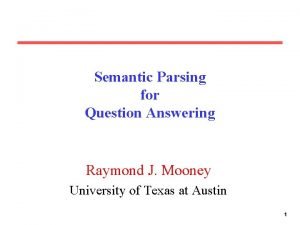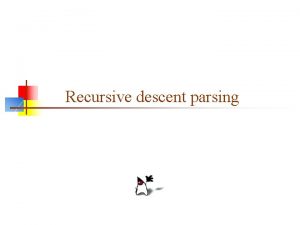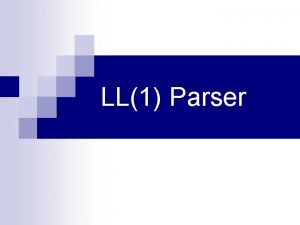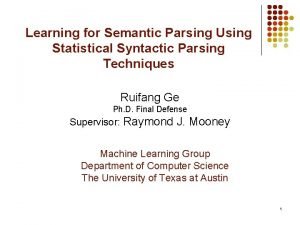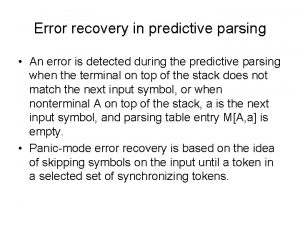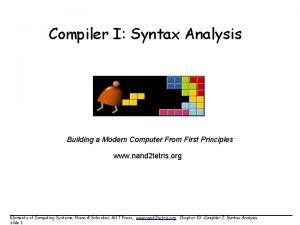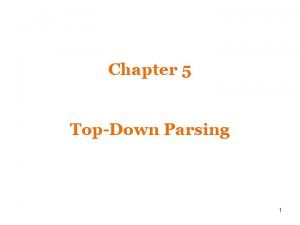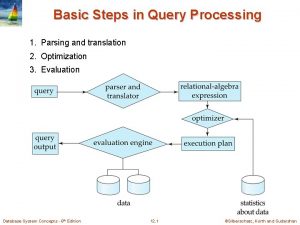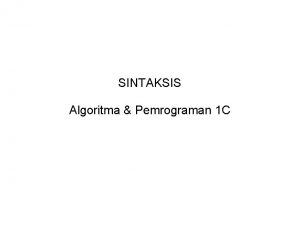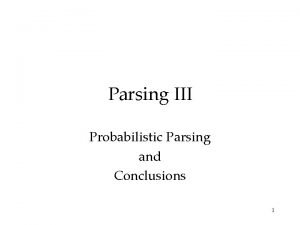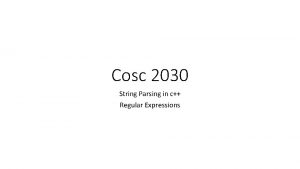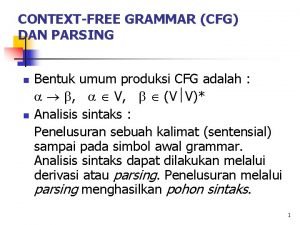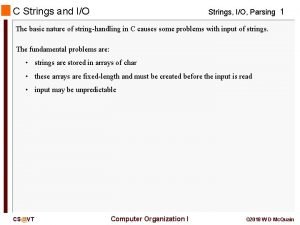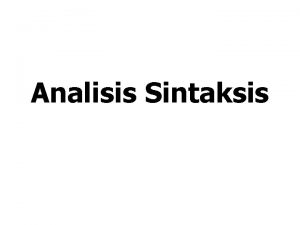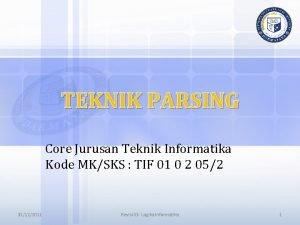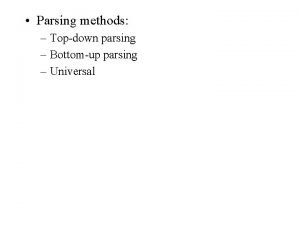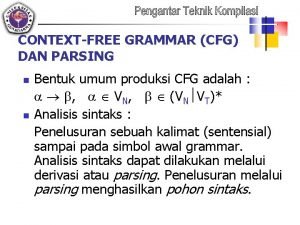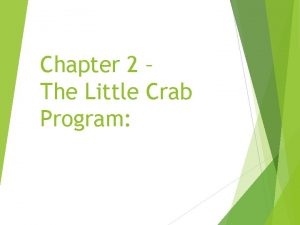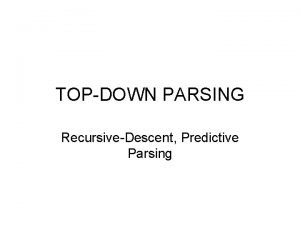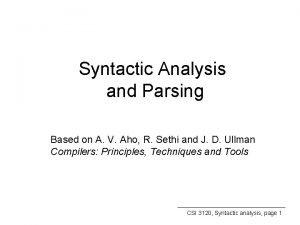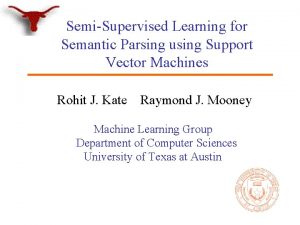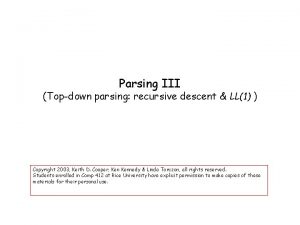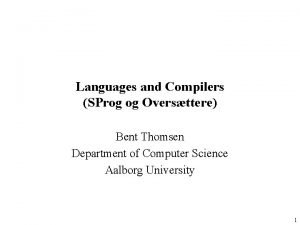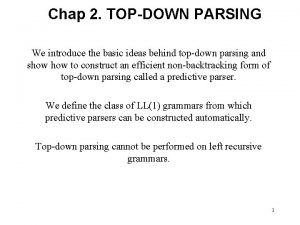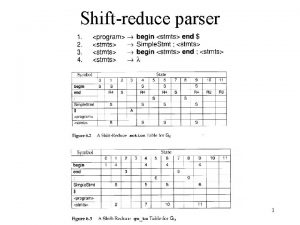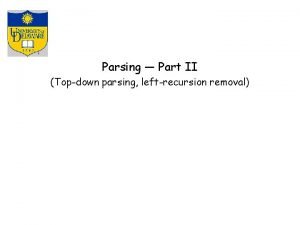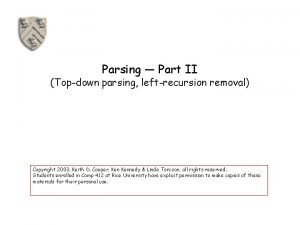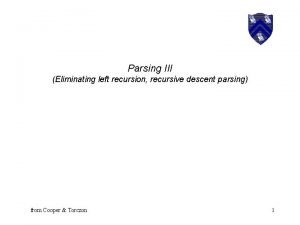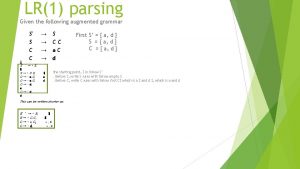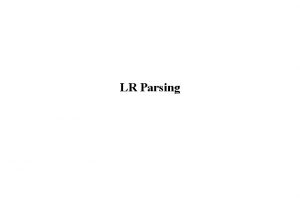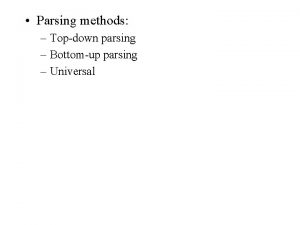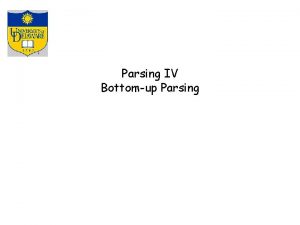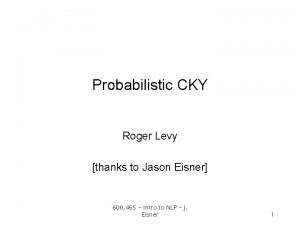NLP Introduction to NLP CockeKasamiYounger CKY Parsing Notes







![Example ["the", "child", "ate", "the", "cake", "with", "the", "fork"] S -> NP VP NP Example ["the", "child", "ate", "the", "cake", "with", "the", "fork"] S -> NP VP NP](https://slidetodoc.com/presentation_image_h2/fc1b7fb2e345e43bc0b908758970e88a/image-8.jpg)
























![A longer example ["take", "this", "book"] S -> NP VP | Aux NP VP A longer example ["take", "this", "book"] S -> NP VP | Aux NP VP](https://slidetodoc.com/presentation_image_h2/fc1b7fb2e345e43bc0b908758970e88a/image-33.jpg)
![Non-binary productions ["take", "this", "book"] S -> NP VP | Aux NP VP | Non-binary productions ["take", "this", "book"] S -> NP VP | Aux NP VP |](https://slidetodoc.com/presentation_image_h2/fc1b7fb2e345e43bc0b908758970e88a/image-34.jpg)








- Slides: 42

NLP

Introduction to NLP Cocke-Kasami-Younger (CKY) Parsing

Notes on Left Recursion • Problematic for many parsing methods – Infinite loops when expanding • But appropriate linguistically – – NP -> DT N NP -> PN DT -> NP ‘s Mary’s mother’s sister’s friend

Chart Parsing • Top-down parsers have problems with expanding the same non-terminal – In particular, pre-terminals such as POS – Bad idea to use top-down (recursive descent) parsing as is • Bottom-up parsers have problems with generating locally feasible subtrees that are not viable globally • Chart parsing will address these issues

Dynamic Programming • Motivation – A lot of the work is repeated – Caching intermediate results improves the complexity • Dynamic programming – Building a parse for a substring [i, j] based on all parses [i, k] and [k, j] that are included in it. • Complexity – O(n 3) for recognizing an input string of length n

Dynamic Programming • CKY (Cocke-Kasami-Younger) – bottom-up – requires a normalized (binarized) grammar • Earley parser – top-down – more complicated – (separate lecture)

CKY Algorithm function cky (sentence W, grammar G) returns table for i in 1. . length(W) do table[i-1, i] = {A|A->Wi in G} for j in 2. . length(W) do for i in j-2 down to 0 do for k in (i+1) to (j-1) do table[i, j] = table[i, j] union {A|A->BC in G, B in table [I, k], C in table [k, j]} If the start symbol S is in table [0, n] then W is in L(G)
![Example the child ate the cake with the fork S NP VP NP Example ["the", "child", "ate", "the", "cake", "with", "the", "fork"] S -> NP VP NP](https://slidetodoc.com/presentation_image_h2/fc1b7fb2e345e43bc0b908758970e88a/image-8.jpg)
Example ["the", "child", "ate", "the", "cake", "with", "the", "fork"] S -> NP VP NP -> DT N | NP PP PP -> PRP NP VP -> V NP | VP PP DT -> 'a' | 'the' N -> 'child' | 'cake' | 'fork' PRP -> 'with' | 'to' V -> 'saw' | 'ate'

the child ate the cake with the fork

the DT child ate the cake with the fork

the DT child N ate the cake with the fork

the DT child NP N ate the cake with the fork

the DT child NP N ate the cake with the fork

the DT child NP N ate V the cake with the fork

the DT child NP N ate V the DT cake with the fork

the DT child NP N ate V the DT cake N with the fork

the DT child NP N ate V the DT cake NP N with the fork

the DT child NP N ate V the DT cake NP N with the fork

the DT child NP N ate V the VP DT cake NP N with the fork

the DT child NP N ate V the VP DT cake NP N with the fork

the DT child NP S N ate V the VP DT cake NP N with the fork

the DT child NP S N ate V the VP DT cake NP N with the fork

the DT child NP S N ate V the VP DT cake NP N with PRP the fork

the DT child NP S N ate V the VP DT cake NP NP N with PRP the PP DT fork NP N

the DT child NP S N ate V the DT cake VP VP NP NP N with PRP the PP DT fork NP N

the DT child NP S N ate V the DT cake VP VP NP NP N with PRP the PP DT fork NP N

the DT child NP S S VP VP NP NP N ate V the DT cake N with PRP the PP DT fork NP N

the DT NP child V the N NP NP VP PP NP PP VP [2] [5] [8] [8] S VP VP NP NP N ate [0] DT [1] [3] DT [4] [6] DT [7] [2] V [3] [5] PRP [6] [0] NP [2] [3] NP [5] [2] V [3] [2] VP [5] [0] NP [2] S ==> ==> ==> [0] [3] [6] [2] [5] [0] [3] [2] [0] NP NP NP VP PP S NP VP VP S [2] [5] [8] [8] DT cake N with PRP the PP DT fork NP N

What is the meaning of each of these sentences?

(S (NP (DT the) (N child)) (VP (V ate) (NP (DT the) (N cake))) (PP (PRP with) (NP (DT the) (N fork)))))

(S (NP (DT the) (N child)) (VP (V ate) (NP (DT the) (N cake))) (PP (PRP with) (NP (DT the) (N fork))))) (S (NP (DT the) (N child)) (VP (V ate) (NP (DT the) (N cake)) (PP (PRP with) (NP (DT the) (N fork))))))

Complexity of CKY • Space complexity – There are O(n 2) cells in the table • Single parse – Each cell requires a linear lookup. – Total time complexity is O(n 3) • All parses – Total time complexity is exponential
![A longer example take this book S NP VP Aux NP VP A longer example ["take", "this", "book"] S -> NP VP | Aux NP VP](https://slidetodoc.com/presentation_image_h2/fc1b7fb2e345e43bc0b908758970e88a/image-33.jpg)
A longer example ["take", "this", "book"] S -> NP VP | Aux NP VP | VP NP -> PRON | Det Nom -> N | Nom PP PP -> PRP NP VP -> V | V NP | VP PP Det -> 'the' | 'a' | 'this' PRON -> 'he' | 'she' N -> 'book' | 'boys' | 'girl' PRP -> 'with' | 'in' V -> 'takes' | 'take'
![Nonbinary productions take this book S NP VP Aux NP VP Non-binary productions ["take", "this", "book"] S -> NP VP | Aux NP VP |](https://slidetodoc.com/presentation_image_h2/fc1b7fb2e345e43bc0b908758970e88a/image-34.jpg)
Non-binary productions ["take", "this", "book"] S -> NP VP | Aux NP VP | VP NP -> PRON | Det Nom -> N | Nom PP PP -> PRP NP VP -> V | V NP | VP PP Det -> 'the' | 'a' | 'this' PRON -> 'he' | 'she' N -> 'book' | 'boys' | 'girl' PRP -> 'with' | 'in' V -> 'takes' | 'take'

Chomsky Normal Form (CNF) • All rules have to be in binary form: – X YZ or X w • This introduces new non-terminals for – – hybrid rules n-ary rules unary rules epsilon rules (e. g. , NP e) • Any CFG can be converted to CNF – See Aho & Ullman p. 152

ATIS grammar Original version S → NP VP S → Aux NP VP S → VP NP → Pronoun NP → Proper-Noun NP → Det Nominal → Noun Nominal → Nominal PP VP → Verb NP VP → VP PP PP → Prep NP From Jurafsky and Martin

ATIS grammar in CNF Original version S → NP VP S → Aux NP VP S → VP NP → Pronoun NP → Proper-Noun NP → Det Nominal → Noun Nominal → Nominal PP VP → Verb NP VP → VP PP PP → Prep NP CNF version S → NP VP S → X 1 VP X 1 → Aux NP S → book | include | prefer S → Verb NP S → VP PP NP → I | he | she | me NP → Houston | NWA NP → Det Nominal → book | flight | meal | money Nominal → Nominal Noun Nominal → Nominal PP VP → book | include | prefer VP → Verb NP VP → VP PP PP → Prep NP

ATIS grammar in CNF Original version S → NP VP S → Aux NP VP S → VP NP → Pronoun NP → Proper-Noun NP → Det Nominal → Noun Nominal → Nominal PP VP → Verb NP VP → VP PP PP → Prep NP CNF version S → NP VP S → X 1 VP X 1 → Aux NP S → book | include | prefer S → Verb NP S → VP PP NP → I | he | she | me NP → Houston | NWA NP → Det Nominal → book | flight | meal | money Nominal → Nominal Noun Nominal → Nominal PP VP → book | include | prefer VP → Verb NP VP → VP PP PP → Prep NP

Chomsky Normal Form • All rules have to be in binary form: – X YZ X w or • New non-terminals for hybrid rules, n-ary and unary rules: – INF-VP to VP • • INF-VP TO VP TO to – S Aux NP VP • • – etc. becomes S R 1 VP R 1 Aux NP – S VP • • becomes VP Verb S book S buy S R 2 PP S Verb PP VP Verb NP VP Verb PP becomes

Issues with CKY • Weak equivalence only – Same language, different structure – If the grammar had to be converted to CNF, then the final parse tree doesn’t match the original grammar – However, it can be converted back using a specific procedure • Syntactic ambiguity – (Deterministic) CKY has no way to perform syntactic disambiguation

Notes • Demo: – http: //lxmls. it. pt/2015/cky. html • Recognizing vs. parsing – Recognizing just means determining if the string is part of the language defined by the CFG – Parsing is more complicated – it involves producing a parse tree

NLP
 Parsing in nlp
Parsing in nlp Morphological parsing in nlp
Morphological parsing in nlp Parsing algorithms in nlp
Parsing algorithms in nlp Nlp lecture notes
Nlp lecture notes Nlp lecture notes
Nlp lecture notes Nlp clinical notes
Nlp clinical notes Simlish phrases
Simlish phrases Top down parsing
Top down parsing Semantic parsing
Semantic parsing Recursive descent parser
Recursive descent parser The first l in ll(1) parsing means
The first l in ll(1) parsing means Parsing syntax
Parsing syntax Error recovery in top down parsing
Error recovery in top down parsing Gj6 parsing
Gj6 parsing Recursive descent parser c
Recursive descent parser c Steps of query processing
Steps of query processing Move the bottom up and down
Move the bottom up and down Yang memeriksa sintaks dan memeriksa relasi adalah
Yang memeriksa sintaks dan memeriksa relasi adalah Parsing adalah
Parsing adalah Probabilistic parsing
Probabilistic parsing End-to-end wireframe parsing
End-to-end wireframe parsing String parsing in c
String parsing in c Cfg adalah
Cfg adalah String parsing in c
String parsing in c Parsing adalah
Parsing adalah Non recursive predictive parsing
Non recursive predictive parsing Mksks
Mksks Soa-ll1
Soa-ll1 Tentang cfg
Tentang cfg Greenfoot reached end of file while parsing
Greenfoot reached end of file while parsing Top down parsing vs bottom up
Top down parsing vs bottom up Predictive parsing
Predictive parsing Lr(0) parsing table
Lr(0) parsing table Semantic parsing
Semantic parsing Predictive parsing
Predictive parsing Dfa
Dfa Predictive parsing
Predictive parsing Parsing
Parsing For top down parsing left recursion removal is
For top down parsing left recursion removal is Left recursion
Left recursion For top-down parsing left recursion removal is
For top-down parsing left recursion removal is Augmented grammer
Augmented grammer Which of these is also known as look-head lr parser?
Which of these is also known as look-head lr parser?

